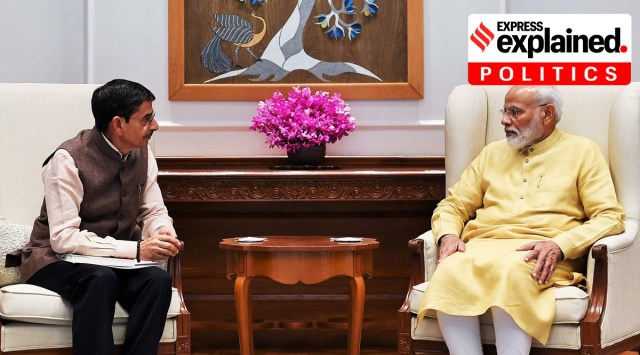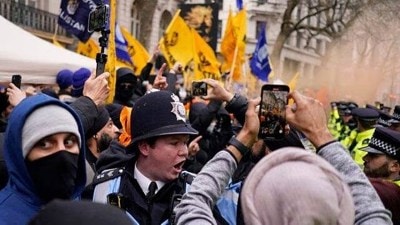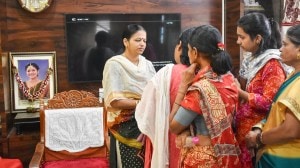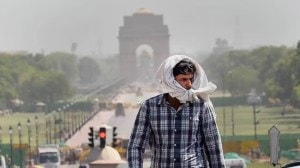- India
- International
Explained: Why has peace process for Naga Accord been stuck, what is the way forward?
Sources in the security establishment say the enthusiasm with which the framework agreement was announced led to unreasonable expectations of an imminent Accord.
 Then Nagaland Governor R N Ravi with Prime Minister Narendra Modi. Now Tamil Nadu Governor, Ravi has quit as interlocutor for the Naga peace talks. (Photo: ANI/File)
Then Nagaland Governor R N Ravi with Prime Minister Narendra Modi. Now Tamil Nadu Governor, Ravi has quit as interlocutor for the Naga peace talks. (Photo: ANI/File)Tamil Nadu Governor R N Ravi on Wednesday resigned as interlocutor for the Naga peace talks. The government is understood to be unhappy over the handling of the Naga peace process by Ravi — who was earlier also the Governor of Nagaland — over the past year and a half, during which time he disagreed openly with the insurgent group NSCN(IM), queering the pitch for the negotiations.
Naga sources have said the NSCN(IM) views Ravi’s removal as Governor of Nagaland and interlocutor as a victory.
What is the Naga peace process?
It refers to ongoing talks between the Indian government and Naga insurgent groups, in particular the NSCN(IM), since 1997 with the aim to sign a Naga Peace Accord.
The Naga insurgency, rooted in Naga nationalism, is one of the oldest insurgencies in the country. The Naga-inhabited areas of the Northeast never considered themselves part of British India, and on August 14, 1947, the Naga National Council (NNC) led by Angami Zapu Phizo declared independence for Nagaland. Phizo formed an underground Naga Federal Government (NFG) and a Naga Federal Army (NFA) in 1952, in response to which the Centre sent in the Army and enacted the Armed Forces (Special) Powers Act, or AFSPA.
After years of talks, the Shillong Accord was signed in 1976 with underground groups of Nagaland, but it was rejected by many top NNC leaders on the ground that it did not address the issue of Naga sovereignty and forced Nagas to accept the Indian Constitution.

Five years later, Isak Chishi Swu, Thuingaleng Muivah, and S S Khaplang split from the NNC and formed the NSCN to continue the armed struggle. In 1988, the NSCN split again into NSCN(IM) led by Isak and Muivah and NSCN(K) led by Khaplang. The NSCN(IM) is dominated by the Tangkhul tribe of Ukhrul, Manipur (to which Muivah belongs) and the Sema tribe (from which Isak hailed) of Nagaland. In 1997, the NSCN(IM) entered into a ceasefire with the Indian government, which gave rise to hope for a final settlement.
 What has happened since?
What has happened since?
There have been nearly 100 rounds of talks. In August 2015, the group signed a framework agreement with the Indian government for the Naga Peace Accord. Ravi was appointed interlocutor to take the talks to their conclusion.
But while both the government and Naga groups said the talks successfully concluded on the government’s deadline of October 31, 2019, no accord was signed. Relations between Ravi and the NSCN(IM) unravelled after the talks concluded. In January 2020, the government had IB special director Akshay Mishra step in and continue the engagement.
How did things go wrong?
Why the IM hardened its stance has never been made public. Sources in the security establishment say things started to go sour after Ravi realised that the NSCN(IM) and the Indian government differed in their understanding of the framework agreement. The group was insistent on a Naga constitution, and was pushing for a Greater Nagalim stretching beyond the boundaries of the present Nagaland state.
Naga sources, however, say that during the talks, the IM had softened its stance on the demand for a separate flag and constitution. Sources say even the various competencies of the accord had been agreed upon, although a few bones of contention remained.
In November 2017, Ravi signed an agreement with seven groups who had come together under the banner of the Naga National Political Groups (NNPGs), which did not include the NSCN (IM). The IM, which considers itself the principal representative of Naga aspirations, has been a rival of many of the NNPG groups. In a letter to Prime Minister Narendra Modi in 2020, the IM accused Ravi of attempting to “segregate the Naga civil society”.
After becoming Nagaland Governor in 2019, Ravi expressed frustration at the delay in concluding the deal. In October 2019, after talks with Naga society representatives, Ravi said the NSCN (IM) had “adopted a procrastinating attitude to delay the settlement” by raising the “contentious symbolic issues of separate Naga national flag and constitution”. A mutually agreed draft comprehensive settlement was ready to be signed, he said.
Ravi wrote a scathing letter to Chief Minister Neiphiu Rio, calling the NSCN(IM) an “armed gang”, and accused it of running a “parallel government” and engaging in extortion.
In response, the NSCN(IM) hardened its position, saying the Naga flag and constitution were non-negotiable. It claimed the framework agreement included the idea of unification of all Naga inhabited areas in Assam, Arunachal Pradesh, and Manipur. It accused Ravi of twisting the document by deleting key words that suggested Nagaland would co-exist with India as a sovereign.
Ravi rejected the demand for a separate flag and constitution outright, and warned that “any misadventure to disintegrate this great nation shall not be tolerated”. The IM responded by calling Ravi’s actions “mischief”, and demanding his ouster. Ravi, meanwhile, continued to engage with the other Naga groups, and declared that the Accord would be signed with or without the NSCN(IM).
Amid all this, what are the real issues?
Sources in the security establishment say the enthusiasm with which the framework agreement was announced led to unreasonable expectations of an imminent Accord.
“The Naga issue is very complex, and the NSCN(IM) is in a delicate position. It is led by a Tangkhul from Manipur, for whom it is difficult to abandon the demand for a Greater Nagalim. But India cannot accept that demand, and a middle path has to be found, which may take some time,” a senior officer said.
Sources said there was no way the government would accept a separate constitution for Nagaland. “This was never under discussion. There was, indeed, an opinion that the flag could be given. But that went off the table after the decisions of August 5, 2019 in Kashmir, when the region’s flag was taken away,” another official said.
Ravi’s open criticism made the NSCN(IM) publicly harden its position, officials said. “There was already pressure on the NSCN(IM) because of NIA cases against its members… There was no need to openly chide them. You can’t be the good cop as well as the bad cop as a negotiator,” a Home Ministry official said.
The move to appoint Ravi as Governor too, did not go down well with the IM. And Ravi’s enthusiasm in matters of governance was taken by the state government as interference.
Newsletter | Click to get the day’s best explainers in your inbox
What is the way forward?
The government has roped in former IB officer Mishra as the new pointsperson for talks. Mishra met some representatives of IM this week, after Assam Chief Minister Himanta Biswa Sarma and Rio met Muivah and others. Mishra, who sources say could be formally appointed the new interlocutor, is known to be a quiet worker, and has been talking to Naga groups since January 2020.
“It is important to understand that there cannot be an accord without the NSCN(IM). It continues to get young recruits and wields considerable influence in the region. The idea is to slowly bring them to accept what India can give,” a senior officer said.
One of Mishra’s tasks would also be to delicately close the gap between the IM and NNPGs, which shared a good relationship with Ravi. Sources in the NNPGs have said they are not averse to working with Mishra; however, they have pointed to the “ambiguity” of his role since, they argue, following the conclusion of the talks on October 31, 2019, “there is no longer a need for an interlocutor”.
Some demands that need ironing out include one for a bicameral Assembly with at least 40 nominated members representing different tribes; absorption of cadres as local armed forces or in the Indian paramilitary; setting up of autonomous councils in Naga-dominated areas of neighbouring states; and the use of the Naga flag for at least customary events.
More Explained
EXPRESS OPINION
Apr 26: Latest News
- 01
- 02
- 03
- 04
- 05










































